Please click here to access the main AHDB website and other sectors.
- Home
- Knowledge library
- Aphids on strawberry: biological control
Aphids on strawberry: biological control
There are a number of biological control options open to commercial strawberry growers, including predators and parasitoids. Find out more about how to use these in this section.
Back to: Control methods for aphids on strawberry
Biocontrol
Several predators and parasitoids are available from suppliers and can be used as biocontrol agents of aphids on strawberry. Suppliers recommend these products are released within 1–2 days following receipt, ideally in the morning or evening when light levels are low.
The most useful biocontrols for aphids are parasitic wasps of various species, including the predatory midge Aphidoletes aphidimyza and larvae of the green lacewing Chrysoperla carnea. A number of other biocontrol agents are also available, such as the ladybird Adalia bipunctata and predatory bugs such as Orius and Anthocoris species, but these are either, at best, only partially effective and may not be considered cost-effective.
- Biocontrol approaches for aphids on strawberry are only likely to be effective and reliable in protected crops
- Biocontrol is unsuitable for aphids in crops for propagation, at least as a stand-alone method, because low populations of aphids can transmit significant levels of virus. There is only a very low tolerance of aphids in the Plant Health Propagation Scheme – nil on high-health stocks
- Because of the large number of aphid species that can occur on strawberry under protection, biocontrol agents with a broad host range that can control several aphid species are preferable to biocontrol agents that are aphid-species-specific
Different biocontrols for aphids on strawberry
With an ever-decreasing number of spray products available to strawberry growers, increasing reliance must be made of biological control options, such as the below:
Aphid parasitoids should be considered as the first line of biocontrol defence against aphids. These tiny, dark-coloured parasitic wasps (see below) lay their eggs inside the aphid’s body to allow the parasitoid larva to hatch and eat the aphid from inside. The aphid turns into a swollen ‘mummy’ (see below) when the parasitoid larva pupates. The new adult parasitoid then cuts an exit hole in the mummy and emerges from the dead aphid.
Aphidius parasitoid adult
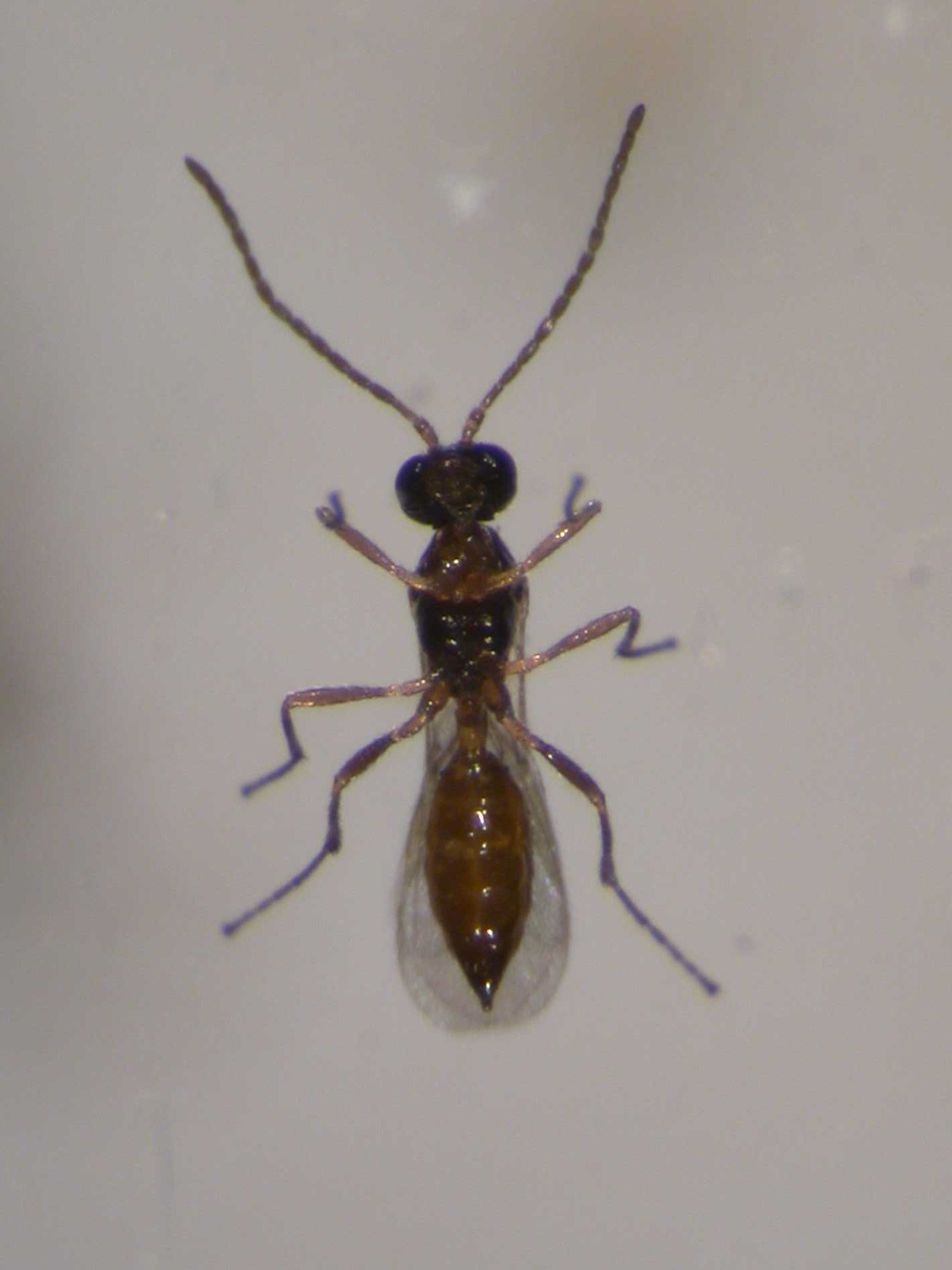
Image copyright NIAB EMR.
Mummy formed by an Aphidius species
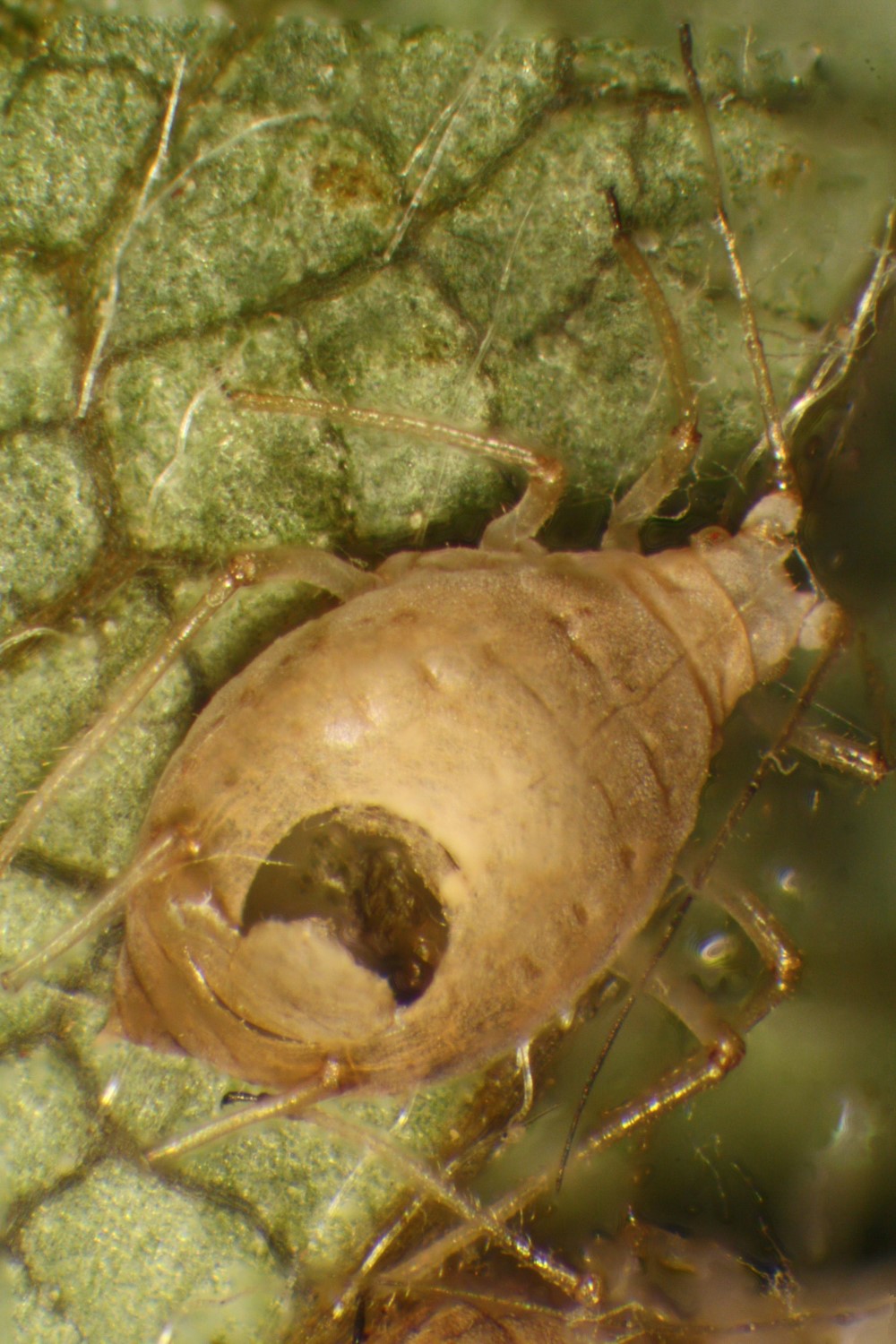
Image copyright RSK ADAS
Parasitoids are very effective at searching for aphids and finding them (often reaching parts of the plants that contact aphicides cannot penetrate), even at low densities. Each female is capable of parasitising many aphids (up to 300) and they may also kill additional aphids for host feeding.
Optimum conditions for parasitoid release
Parasitoids can be released as a preventive treatment as soon as the crop starts to grow, as early as late February or early March. Although the temperature conditions are not ideal for the parasitoids so early in the season, research carried out as part of Project SF 156 shows that the wasps can survive even at temperatures close to freezing and can find and lay their eggs inside aphids when the temperature increases by just 6–11oC for brief periods (less than 2 hours) during the middle part of the day. So parasitoids released in late winter are likely to survive to find and parasitise aphids. It should be noted that parasitoids will develop very slowly at these temperatures and may take several weeks to complete their life cycle. The absence of mummified aphids does not, therefore, reliably indicate lack of parasitoid activity.
Which parasitoid species are available?
Several species of parasitic wasps are commercially available for aphid control. If growers are confident about the identification of the pest aphid, then releasing a single parasitoid species can provide very cost-effective control. Aphidius colemani is particularly effective at parasitising melon and cotton aphid, whereas Aphidius ervi is much better suited to controlling potato aphid. However, for preventive releases, mixed aphid populations or where aphid identification is uncertain, mixes of five or six parasitoid species are available from several suppliers and provide a higher chance of successful control. Unfortunately, none of the commercially available parasitoid species are effective against strawberry aphid. A naturally occurring parasitoid, Aphidius eglanteriae, is often found in strawberry plantations and can help to keep strawberry aphid numbers in check (AHDB Project SF 61), but numbers generally lag behind the population growth of the aphid.
Products containing individual parasitoid species may be supplied as aphid mummies in a granular carrier material that can be gently scattered over plants. Mixes of species are supplied in cardboard tubes that can be placed in a sheltered spot in the crop canopy and opened to allow adult parasitoids to emerge.
Recommended rates of introduction for parasitoid species mixes
|
|
Average rate of predator introduction |
|
Preventive treatment |
0.3/m2/week |
|
Curative treatment of low populations |
0.5–1.0/m2/week |
The predatory midge Aphidoletes aphidimyza is the most useful and effective biocontrol predator for control of aphids on strawberry. It has a wide host range and can control all the aphid species that occur on strawberry and is effective when used to supplement the control achieved by parasitoids. However, the midge should not be used as a preventive measure, as it only gets established when the aphids are already present.
Adult midges are mainly active at night. Adult Aphidoletes use spiderwebs to find each other. Females search for aphid colonies in which to lay their eggs. The number of eggs laid depends on the density of the aphid colony. The midge larva that hatches is bright orange and immediately attacks the aphids (see below). The larvae inject a poison into an aphid to paralyse it and liquefy it internally, making it easier for the larvae to consume. When many aphids are available, the midge larvae kill more aphids than they can consume, making the midge a very effective and reliable predator. In experiments at NIAB EMR (AHDB project SF 61), midge larvae consumed a mean of 45 young strawberry aphids during their development.
Aphidoletes aphidimyza adult
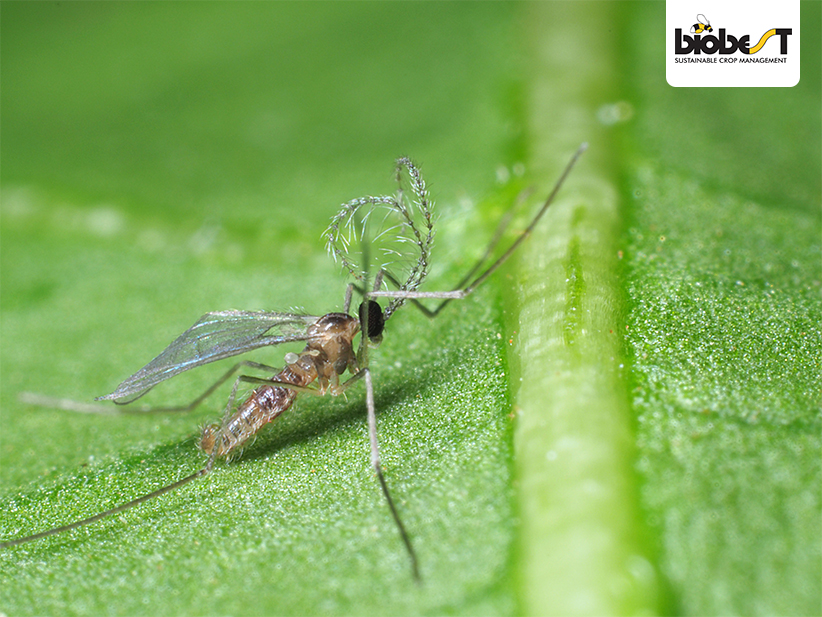
Image copyright Biobest, used with permission.
Aphidoletes aphidimyza larva attacking an aphid
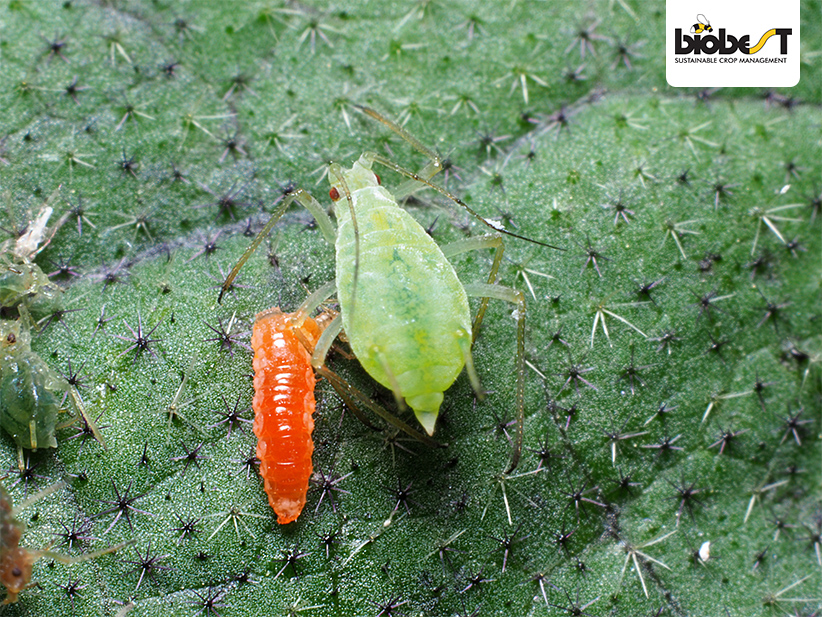
Image copyright Biobest, used with permission.
Optimum conditions for Aphidoletes aphidimyza to be successful
Temperature has a marked effect on the activity of Aphidoletes aphidimyza; in particular, a minimum dusk and night temperature of approximately 15oC is required. This limits the use of Aphidoletes until about mid-May at the earliest in tunnels, although the midge may be used prior to this in heated glasshouses. Aphidoletes aphidimyza also needs at least 15 hours of daylight per day to complete its development, which limits its use to between April and September, unless there is adequate supplementary lighting.
Aphidoletes aphidimyza pupates in the soil and the midge may be less successful at completing its life cycle where the soil or growing medium is covered with polythene. This may prevent the midge from establishing and prolong the need for introductions.
The midge is supplied as late pupae in a variety of packing methods, but in all cases, follow the manufacturers’ instructions. Pupae may be provided loose in vermiculite for placing on moist growing media or inside blister packs that can be opened and hung on shaded leaf stalks.
This biocontrol agent needs high humidity conditions both for adult emergence and to successfully find its host and reproduce. In field experiments, where four introductions of adult midges were made to control strawberry aphid, very few midge larvae were found in subsequent leaf samples and there was no effect on aphid numbers (AHDB Project SF 61). However, Aphidoletes are more effective in tunnels and the success of the released midges can be improved by providing compost-containing buckets to help support emergence of adults from the pupae and their subsequent survival.
This consists of a plastic, lidded bucket with damp capillary matting and compost in the bottom (see right). Aphidoletes supplied in the vermiculite carrier material can be scattered on this moist surface and covered with a further thin layer of compost. With frayed nylon string provided, hanging into the bucket (serving as artificial spiderwebbing for midge resting and mating (see below), and holes punched in the bucket lid (helping to maintain a humid environment while allowing release of midges into the tunnel), these refuges can help to improve the consistency of the Aphidoletes-based biocontrol system.
Protective ‘bucket’ system to support released Aphidoletes populations
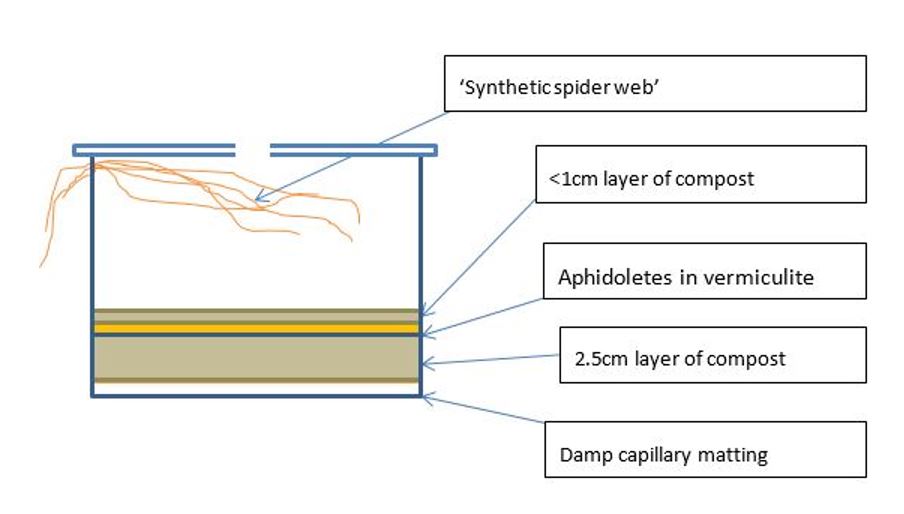
Method and diagram provided by Neal Ward (Biobest) and used with permission.
The recommended rate of introduction (whether released via the bucket system or applied directly to plants or the growing medium) depends on the density of aphid population, as follows:
|
|
Average rate of predator introduction |
|
Treatment of low populations |
0.5–1.0/m2/week |
|
Treatment of higher populations |
1.3/m2/week |
|
Treatment of aphid hotspots |
5–10/m2 as a one-off introduction |
It is recommended that a series of introductions should be made until the midge is well established and the aphids effectively controlled. A hand lens can be used to search aphid colonies for signs of the larvae. Take care when releasing predatory mites or Orius for thrips control, as these predators may feed on Aphidoletes eggs.
The adult midges are very sensitive to spray control products, the midge larvae moderately so. Avoid using harmful products if possible, especially persistent ones.
Aphidoletes aphidimyza offers good potential for biocontrol of the range of aphid species typically found in strawberries.
Protective ‘bucket’ with lid removed, showing nylon string and emerged Aphidoletes adults resting on inner surface
_Edited.jpg)
Image by Neal Ward (Biobest), used with permission
Lacewing larvae, such as the green lacewing Chrysoperla carnea (see below) also have promise for aphid control in strawberry. They are voracious predators and each larva may consume up to 800 aphids during its development, potentially preying on any aphid species in the crop. However, their effectiveness and reliability are variable and release of more than five larvae per plant may be needed to significantly reduce aphid numbers on strawberry plants. They are more tolerant of low temperatures, and some chemicals (e.g. fungicides), than Aphidoletes aphidimyza and parasitic wasps such as Aphidius colemani and A. ervi. They are easy to observe within the crop to check establishment, and adult females lay eggs on long stalks, usually on the undersides of leaves. Release rates of about 10/m2/week are normally used for curative treatment and lacewing larvae are particularly recommended for treating hotspots of aphid outbreaks within the crop. However, they are not suitable for preventive release as they do not survive for long without plenty of aphids or other pests to feed on.
Larva of the green lacewing Chrysoperla carnea

Image copyright NIAB EMR.
The hoverfly Sphaerophoria rueppellii is available for aphid control, supplied as pupae. The female adults that emerge are capable of laying up to 400 eggs and each larva is a voracious aphid predator. However, this species works best when the temperature is above 25oC and is therefore not so well suited to spring and autumn UK conditions. An alternative species, Eupeodes corollae, is now also available to UK growers for aphid control and shows promise for use with strawberries. This species may be more suitable for release earlier and later in the season, but it is new to the market and not fully tested in UK conditions.
When the crop is in flower, hoverflies also make significant contributions to pollination. The adult insects rely heavily on sources of nectar and pollen for successful establishment in protected crops and they are therefore not suitable for use pre-flowering unless other food sources can be provided (e.g. using companion flowering plants such as Alyssum). Artificial flower feeders, providing sugar water as hoverfly energy sources, are being investigated but are not currently commercially available.
Various other predators, such as ladybirds (Adalia bipunctata), and predatory bugs, such as Orius and Anthocoris, are also available from biological suppliers and will predate aphids in strawberry crops. However, they are costly and their effectiveness and reliability for aphid control are unproven. They may be useful in aphid hotspots where rapid control is required. In cage experiments to determine the effectiveness of Orius laevigatus in reducing strawberry aphid numbers on potted plants (AHDB Project SF 61), a single release of three and 15 adults (males plus females) per six plants significantly reduced strawberry aphid numbers four weeks after release. This needs to be validated in field experiments on tunnel-grown strawberries. Multiple releases should give quicker control.
Topics:
Sectors:
Tags:

